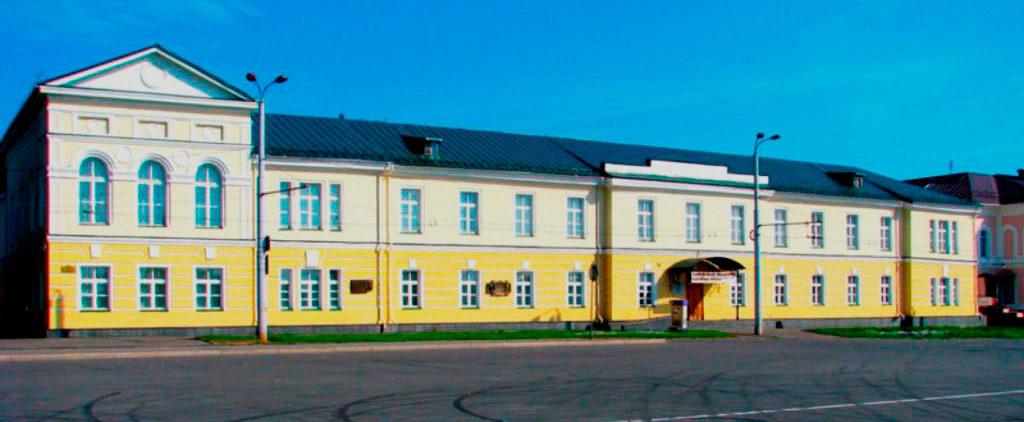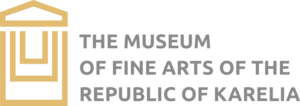The Fine Arts Museum of the Republic of Karelia is situated in the historic center of Petrozavodsk in the former Cathedral Square, in one of the old stone buildings. This building – the architectural monument of 18 century had a lucky lot mission for two centuries – carry out a noble mission of enlightenment. In different years it housed a public school, Olonets Grammar School for boys, Public Library, Pioneer Palace and Vocational School of Culture.
Among the graduates of Olonets Grammar School there are names of outstanding people, who are the glory of Russian history: V.G. Benedictov (1807-1873), a famous Russian poet, contemporary of A.S. Pushkin; V.A. Dashkov (1819- 1896), the director of Moscow Public and Rumyantsev museums; V.D. Polenov (1848-1927), artist, renowned master of Russian painting, F.F. Fortunatov (1848-1914), a most prominent linguist, founder of Moscow school of linguistics. The names of V.D. Polenov and F.F. Fortunatov are immortalized on memorial plaques on the museum walls.
The Grammar School was frequently visited by the royal family members. In1819 it was visited by the Emperor Alexander I, in1858 – Alexander II, in1863 – Prince Nikolai Alexandrovich accompanied by Adjutant-General Earl S.G. Stroganov and outstanding artist A.P. Bogolyubov.
The history of the building is closely intertwined with fate of the city and people of Petrozavodsk tenderly call it “the House on the Square”.
It is quite symbolic, that exactly in this building, where a special spiritual atmosphere continues to live; in 1960 the Fine Arts Museum of the Republic of Karelia was opened.
The first steps for creating museum collections in Petrozavodsk were made in the 30s of 19 century. In connection with the upcoming trip of the heir Prince Alexander Nikolaevich in 1837, all provincial cities got circular letters on the necessity to open special exhibitions for his visit, which would clearly reflect places of interest of the region. The first Petrozavodsk exhibition called “Museum” that included over 3000 items – mainly examples of production and artwork of fine iron casting of the Alexandrovsky (former Petrovsky) iron foundry, – was opened in 1838.
Museum business in Olonets province started developing, when in 1870 a natural-industrial and historical-ethnographic museum was established, which also had art collections. In 1903 in Petrozavodsk under the Olonets eparchy a museum stock was established which was called Drevlehranilishe (Archive). Olonets Eparchy Church Archive (from 1917 to 1920 – Church and History Museum) – was the first in Karelia museum with an art collection. Its basis was formed by icons and church artifacts removed from old-believers’ monasteries. Today, the surviving part of this reserve is included in the icon painting collection of the Museum.
Revitalization of artistic life was connected with the arrival of V.N. Popov in 1915 and A. Y. Andrianov in 1918 – both of them graduates of the Art Academy. Since late 1930s, artists and citizens of the city more and more often raised the issue on establishing an art museum in Petrozavodsk. The State Museum of Local History, without having an art department, united all the collections available in the city: Olonets Church Archive, folk applied arts and icons, as well as works of art received in 1928 from the State Museum Fund. Besides, the museum kept works of art received from private collectors and purchased from Karelian artists and visiting masters. As the number of exhibits grew, the conditions for their keeping, restoration and advertizing became more complicated. Especially critical was the situation after the war, when in 1945 according to the peace treaty about one thousand icons were returned to Karelia from Finland that had been exported by the Finns during the war from Zaonezhie.
Thus, systematic work on research and collection of monuments of ancient Russian art in Karelia, active quantitative increase of the collection as well as lack of normal conditions for keeping, made the leaders of the republic expedite the resolution of the issue connected with establishment of the Fine Arts Museum, which opened its doors to visitors for the first time on October 20, 1960.

